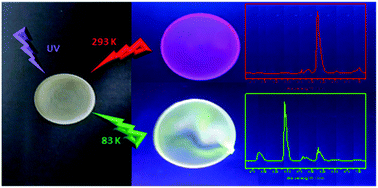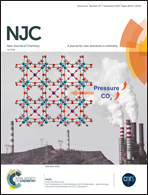A highly sensitive luminescent ratiometric thermometer based on europium(iii) and terbium(iii) benzoylacetonate complexes chemically bonded to ethyldiphenylphosphine oxide functionalized polydimethylsiloxane†
Abstract
This work reports on a ratiometric optical temperature probe consisting of a pdms-eddpo(1%)-[Tb0.90Eu0.10(bzac)3](0.25%) membrane where lanthanide(III) complexes are chemically bonded to ethyldiphenylphosphine oxide functionalized polydimethylsiloxane. The ratiometric luminescent temperature probe shows a maximum relative thermal sensitivity of 11.05% K−1 at 203 K, being one of the most sensitive lanthanide systems reported so far. Besides that, the operational range of the ratiometric probe is 158–248 K, where few systems have high sensitivity. Energy transfer is evident from terbium(III) to europium(III) contributing to the high relative thermal sensitivity of the systems. The optical probe is reversible showing a temperature uncertainty smaller than 0.08 K in the operational range.



 Please wait while we load your content...
Please wait while we load your content...